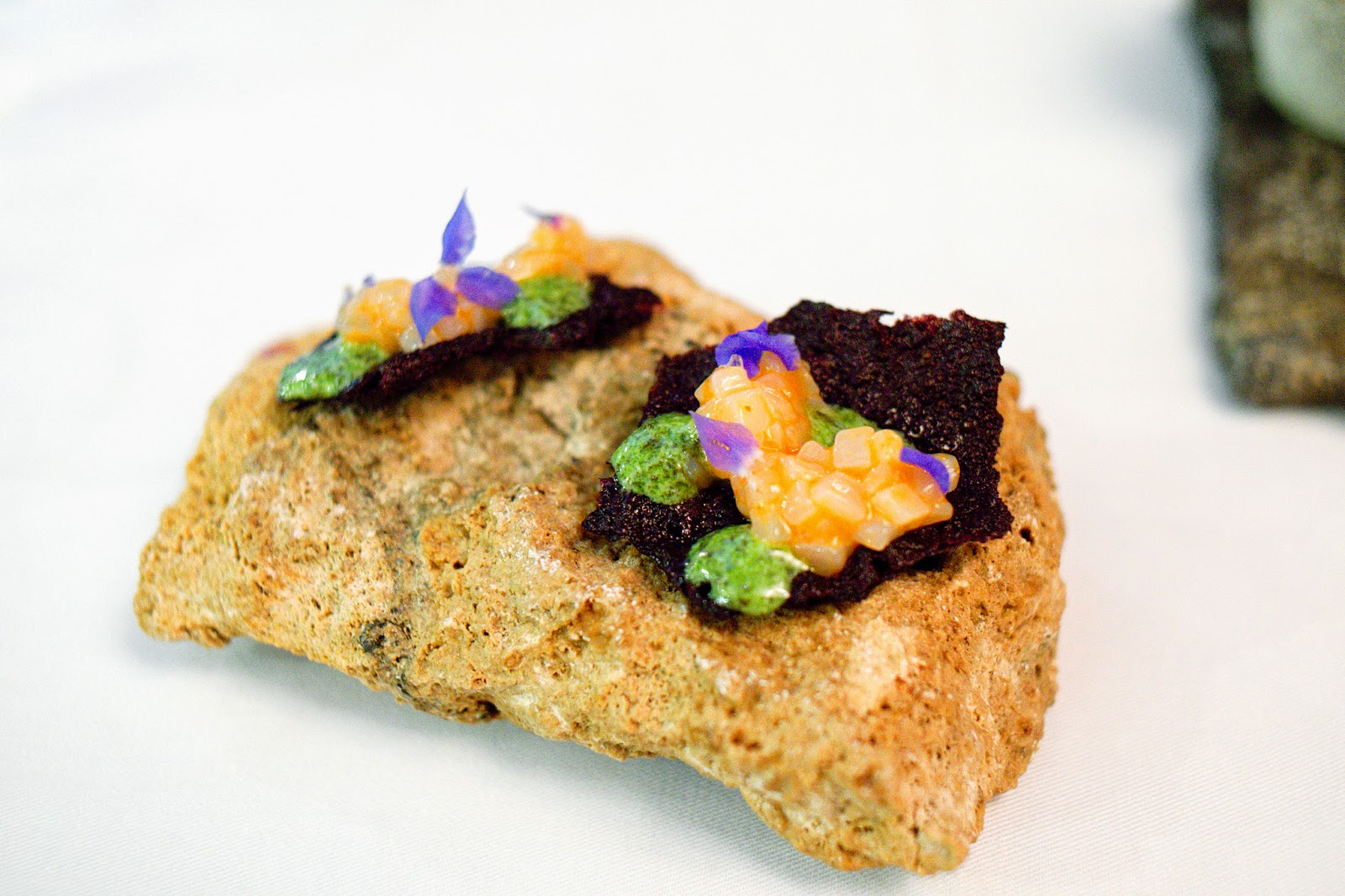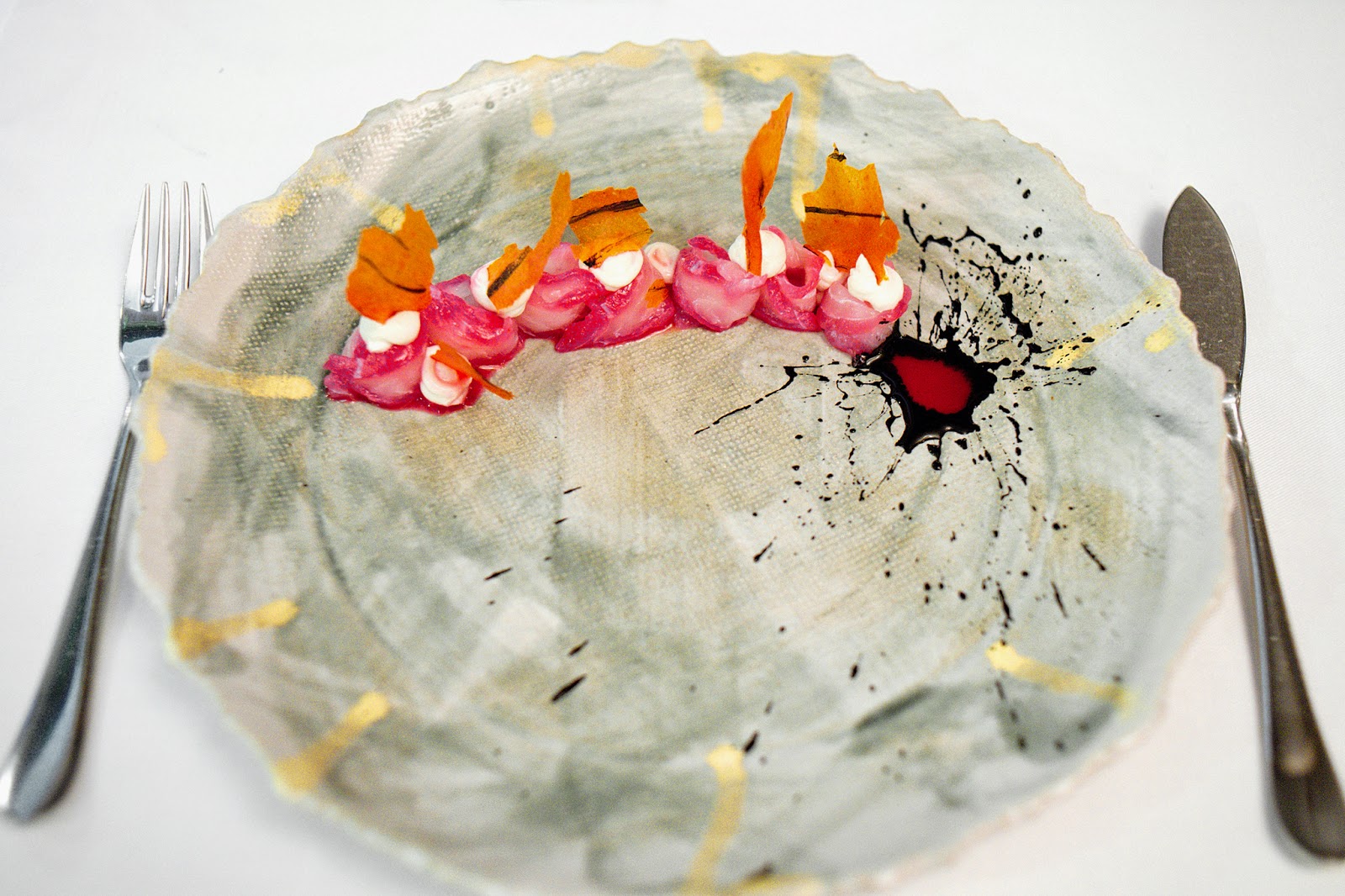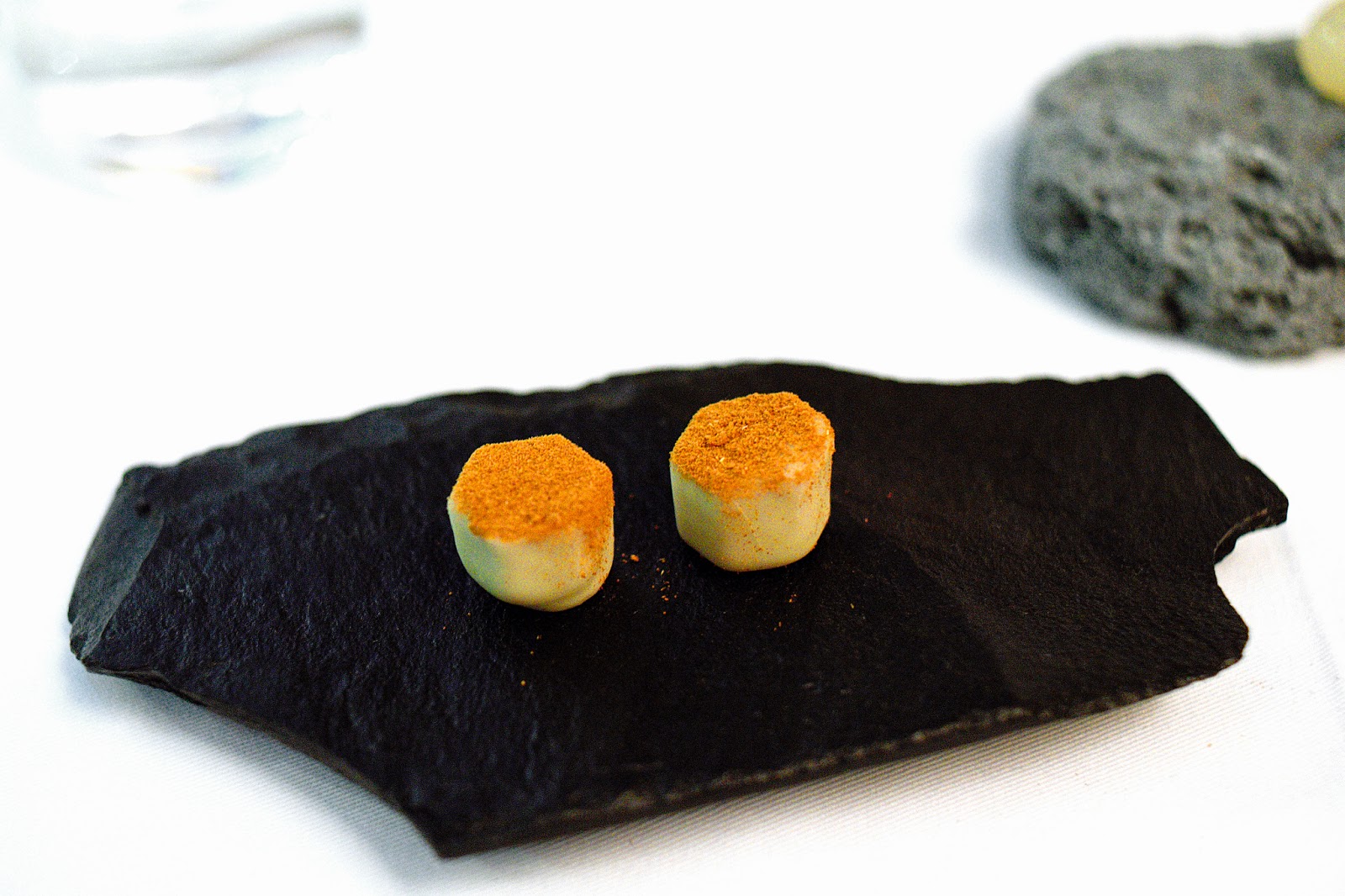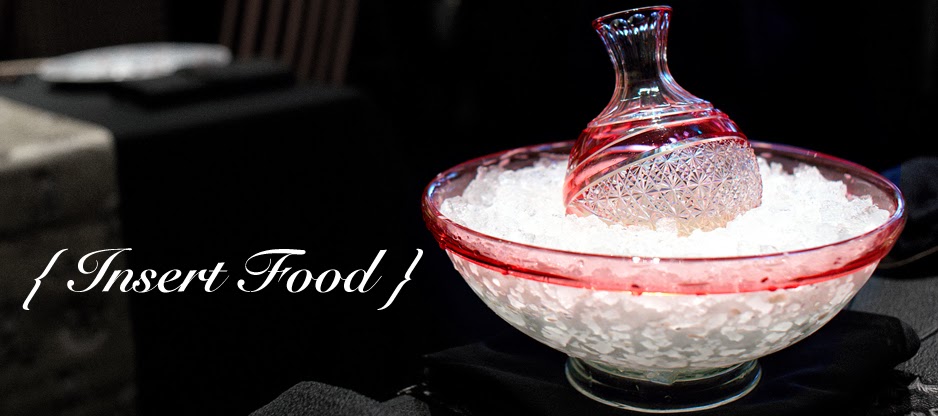Dinner - Friday, May 9, 2014
Rarely, a meal changes the way you think about food. For me, the most recent place that has succeeded in this regard was Saison (ca. 2011). And now,
Virgilio Martinez has done it. This was a truly fantastic meal - every aspect carefully considered, every bite delicious. Central was, far and away, the best meal we had in Peru.
Like many of the modern high-end kitchens, Central has a research team - here, it is the
Mater Iniciativa (read their blog/field notes
here), devoted to rediscovering the ingredients of Peru and "linking the cultural and biological diversity of Peru with the culinary experience". It is the Mater's discoveries that drive Martinez's sophisticated, thoughtful cuisine. Tonight, the theme of our menu was
Elevations - each dish a slice of Peru's many ecosystems, spanning the waters of the Pacific coast to the snow-capped Andean peaks.
 |
"The Sixty-mile Fish" (-5 m)
Squid, huarango, clam |
The huarango tree, native to the dry southern regions of Peru, produces a sweet maple-like sap. Here, it accented the natural sweetness of the raw seafood with some earthiness - a great start.
 |
"Orchard of Mala" (290 m)
Radish, sacha inchi leche de tigre |
An exquisite radish from the gardens of Mala (just south of Lima) sat in a shotglass of leche de tigre infused with
sacha inchi seeds, which lent a nutty, slightly roasty flavour. The acidity of the lime in the tiger's milk was bracing - an interesting contrast with the sweetness of the previous course.
 |
"Dry Andes" (3200 m)
Chaco clay, citrus flower |
Now this was
fascinating - edible clay from the plains of Chaco, served cold. It was sweet (I was assured this is natural), slightly gritty (as one might expect) and tasted of black sesame. Certainly the first time I've been so happy to eat dirt.
 |
"Four-month Tuber" (120 m)
Sweet potato, chamomile petal |
To contrast the Chaco clay,
hot cubes of a native potato variety, dried in the kitchen for 4 months before roasting - very creamy, with a concentrated yam-like flavour.
 |
"Diversity of Corn" (1800 m)
Four corns, three textures |
 |
"Moraya of Paucartambo" (3900 m)
Wild muña, veal heart |
Imagine the most intense mint you've ever tasted. Now, triple that and you may approximate our encounter with muña. This potent herb, innocently dubbed "Andean mint", was remarkably balanced by shavings of dried veal heart.
NB: the name of the dish refers to the white "rocks" underneath, which are actually tubers. The indigenous people of Paucartambo subject these tubers to repeated day-night cycles of freeze-thawing to break down the bitter glycoalkaloids within. Alternately placing them in an icy river, then allowing them to dry/thaw in sunlight results in dehydration and sun-bleaching, producing the bone-white appearance of the moraya. The samples here were not edible.
 |
"High Jungle" (1250 m)
Yacon, egg yolk, coffee |
Coffee crisps were embedded in a rich egg yolk cream - almost a dessert. These were accompanied by cubes of yacon, a jicama-like root vegetable with a more complex, estery flavour. Pure Amazonian ingredients.
 |
"Tree Root and Leaf" (450 m)
Hearts of palm, macambo |
 |
"Harvest of Scallops" (0 m)
Kañihua, tumbo, starflower |
Local scallops, coated in crunchy kañihua (a grain from the quinoa family), were very similar to bay scallops - I generally prefer their larger cousins. These were accompanied by a floral sauce made from tumbo, the banana passionfruit.
 |
| Coca leaf bread, toasted butter |
 |
| Potato bread |
 |
| Airampo bread |
I only mention bread service when it's very good, and these breads were excellent. All three types were served together, with a side of creamy
browned butter (it was amazing - why haven't more restaurants picked up on this?). The
airampo (prickly purple pear) bread elicited comparisons to cranberry, but the herbal coca bread was our favourite - a thin, crispy crust that cracked to yield a moist, still-steaming interior.
 |
"Red Amazon" (148 m)
Arapaima, huito, airampo |
Arapaima (a freshwater fish better known to us North Americans as paiche) was marinated in purple-red
airampo juice and dressed with a hearts of palm cream - nicely balanced. The jet-black sauce is the oxidized juice of the
huito fruit, produced by wrapping and cooking it in banana leaf.
 |
"Valley Between the Andes" (2750 m)
Avocado, tree tomato, kiwicha, beet powder |
 |
"Coastal proximity" (0 m)
Octopus, purple corn, limo chili |
 |
| Purple corn broth |
Really great octopus - a hard sear accenting the slightly toothsome meat. A disc of mashed corn was sweet, contrasting the more sour sauce. The warm broth had a touch of heat from the chili - damn good with the components on the plate.
 |
"Extreme altitude" (4100 m)
Frozen potato, cushuro, mullaca, chincho |
A ridiculously thick potato purée was topped with pearls of
cushuro - each sphere is a colony of cyanobacteria, which grow at high altitude (above 10,000 feet) in springs and pools. They tasted quite neutral, although the "pop" of each ball was fun. The punchiness in the dish came from the medicinal
mullaca powder and bright green aromatic
chincho leaves. A little goes a
long way with these native herbs.
 |
"Altiplano and Lakes" (3900 m)
Lamb, wild mustard, black quinoa |
Tender, gamey lamb, peeking out from under shards of crisp lamb's milk skin - about as good as it gets when it comes to meat courses. The adjacent pool comprised firm black quinoa grains, and a sauce of their greens - a great counterpoint to the rich, meaty side of the plate.
 |
"Untamed Jungle" (145 m)
Bahuaja nut, camu camu, huampo |
Cubes of ice cream made from toasted Brazil nuts (
Bahuaja refers to the Bahuaja Sonene National Park, which yields nuts of particularly high quality) had a mysterious but very alluring flavour. Crisps of burnt Brazil nut chips covered some tangy
camu camu (famous among health food advocates for having a super-high Vitamin C content). The most intriguing part of the dish was the green sorbet, made tableside by
scraping the frozen bark of the huampo plant - again, the flavour was entirely unfamiliar and best described as "medicinal".
 |
"Coca Forest" (845 m)
Cherimoya, coca leaf, theobromas |
 |
| Cold-brewed coffee |
 |
"Cacao Solar Infusion" (450 m)
Stevia, culen, sisal |
The restaurant is quite proud of its rooftop reverse osmosis water filtration system (I'm not sure I recall any other place that charges as much as Central for house water, which peeved me a bit). The infusion tasted predominantly like a chocolate tea (which seems to be quite popular here, based on the number of places we saw it), made by steeping cacao shells in water. I couldn't discern the other herbs clearly, since I have not had
culen or
sisal in isolation.
 |
| Algarrobina bonbon |
A very popular flavouring agent in Peru,
algarrobina (black carob syrup) is evidently commonly used as a chocolate substitute, although they do not taste alike to me. Actually, this bonbon was better than the vast majority of chocolate-based versions I've had - great texture and a more complex sweetness.
 |
| Pisco sour jelly |
 |
| Cocoa |
 |
| The rooftop garden |
We received a tour of the rooftop garden and kitchen after dinner, meeting Virgilio Martinez and part of the Mater team (according to the kitchen crew, Martinez practically lives at the restaurant). It's hard not to be enamored with what they're doing - the passion, curiosity and pride in this kitchen is palpable. Others have undoubtedly paved the way for them, but I suspect the team at Central is now leading the charge of modern Peruvian cuisine. I wish these guys the very best - this was a meal that will be engraved in my memory for a long time to come.
Central
Ca. Santa Isabel 376
Miraflores, Lima
Peru
Phone: +51 (1) 242-8515


























